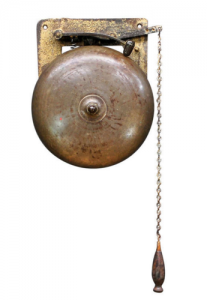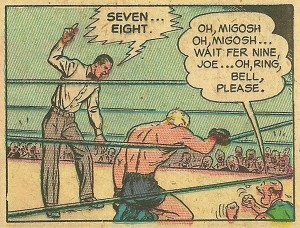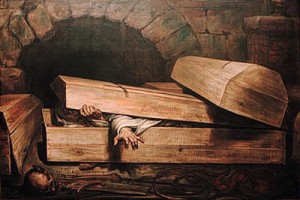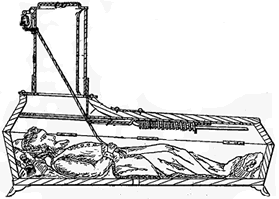Billy: Wow, that was close. Just when I thought the cops would see us, they got distracted by the sound of the bell on Margo’s cat’s collar.
Tom: Yeah, we were saved by the bell. Literally.
The idiom saved by the bell expresses the idea that someone or something is rescued from a dire outcome by a timely occurrence, generally speaking, at the last possible moment, i.e., in the nick of time. A close shave.
Origin

Saved by the bell originated from attempts starting in mid-19th century England to more fully develop and codify rules governing boxing matches.


Most familiar, as well as most significant of these efforts to regulate boxing were the Marquess of Queensberry rules, which among other things specified that fight matches consist of three-minute rounds, each separated by one-minute breaks.
In the course of a round, a boxer who receives a knockout blow is said to be down for the count. If the fighter is unable to regain his footing during the count, which lasts 10 seconds, he or she is declared “out” by the referee, thereby losing the match.
However, if the ringside bell signaling the end of the round sounds before the count is over, the fighter is said to be saved by the bell.
According to the good people at The Phrase Finder, which is pretty much the gold standard for information regarding idioms, the expression saved by the bell was probably in use by the later part of the 1800s, with its earliest print appearance occurring in 1893 in the Massachusetts newspaper, The Fitchburg Daily Sentinel, in relation to a prizefight. Soon thereafter, saved by the bell started being used to describe just about any kind of close call.
Two other origin stories for saved by the bell continue to surface on the web, one tale colorful (and creepy!), the other related to everyone’s school-day memories. While both have an air of what Steve Colbert refers to as “truthiness” about them, both accounts fit into the category of folk etymology, or something like that.

Debunked Origin Theory #1—Specially Rigged Coffins

Back in the 18th and 19th centuries cholera epidemics stoked fears of being buried alive, which in turn lead to various concepts and patented designs of what were referred to as “safety coffins.”
Each description of these caskets includes a number of features, including a window to allow monitoring the presumed dead person for signs of life, a tube for providing fresh air, and most importantly, some sort of device that would enable an entombed victim to ring a rescue bell posted above the gravesite.
But while the Internet is full of illustrations and photos of various fail-safe “corpse containers” there are no references – nada – about any of these types of coffins actually saving anyone. Also, there seems to be no accounts of anyone using the idiom prior to those related to the rules of professional boxing.
Debunked Origin Theory #2— School Daze
One of the most shared mid- and upper-school experiences is the sound of a bell, chime or buzzer to signal the beginning and end of a school day, and the division of that day into equal time periods for different classes, lunch times, and study halls.

Many former students recall something like the following scenario. Your American Literature assignment was to read Edgar Allan Poe’s story “The Premature Burial,” which of course you totally forgot to do. So when Mrs. Gruber awakens you with a question, your mind’s a blank. You are trapped. Like a rat.
And then, the bell, signifying the end of class, rings (with apologies to Poe’s poem, “The Bells”), and Am. Lit class is over. Saved by the bell!
But putting aside any empathy one might have with sleepy students and ringing bells, again, all “origin” references for saved by the bell point first to its use in connection with boxing terminology. Case closed. And this post is closed.
However…
Any discussion about the idiom saved by the bell would be incomplete without mentioning the classic classroom TV comedy series shown below.
